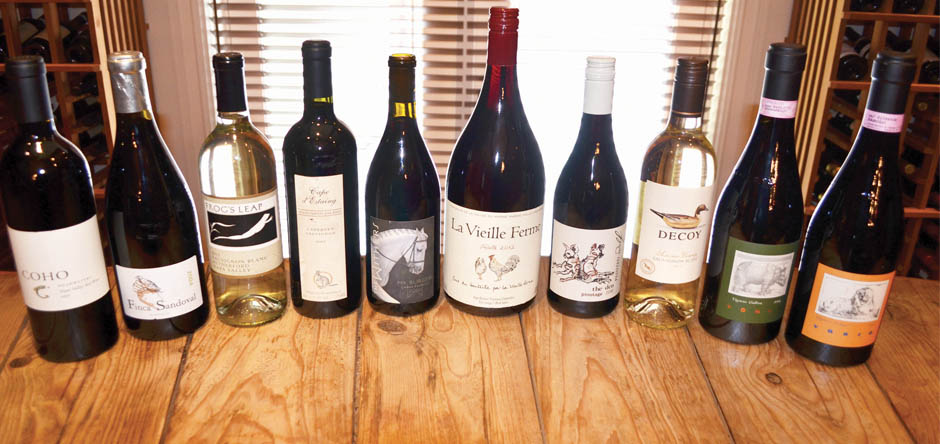So, what’s in a label, specifically a wine label that tempts a shopper to pick it up off its shelf, read a bit from the front and back and bring it to the cash register? The majority of wine purchased in this country is bought to be consumed that evening. The person shopping for dinner will often stop by the wine store and look for a proper wine pairing. Anyone who has been in a well-stocked wine store recently can’t help notice the proliferation of so-called “Critter Labels.” Back in the day, labels told you the producer name, maybe showed a picture of the château, and offered up little else. France, Italy and Spain, the main wine producers from the pre-1980 era, often wouldn’t tell you the grape, with the notable exception of France’s Alsace region. A certain knowledge of the region and typical grapes was expected. Wine was not a regular go-to drink. Bars would serve up beer and cocktails. But somehow when California first nudged, then barged its way into the international wine market, labels began to change.
The date was May 24, 1976 and Steven Spurrier, a British wine educator and wine store proprietor in Paris, tasted a few California wines and was impressed. He decided to arrange a blind tasting of California wines and the pedigreed wines of France. The French wine producers stacked the deck in their favor. They insisted the tasting must happen in Paris. Shipping wines great distances in questionable conditions can give the wine a temporarily unsettling quality. The producers also insisted all the judges must be French with impeccable wine reputations and credentials. Spurrier arranged this and, to everyone’s complete shock, California wines took first place in both the red and white category. The red winner, a 1973 Stag’s Leap SLV Cabernet Sauvignon beat out two of Bordeaux’s first growth wines, Château Mouton Rothschild and Château Haut-Brion. And the 1973 Château Montelena Chardonnay from Calistoga, Calif., bested the famous Burgundian producers, Meursault-Charmes Roulot and Bâtard-Montrachet Ramonet-Prudhon, both in the ’73 vintage. Indeed, at this blind tasting, California wines took six of the top 10 spots in both the white and red category. George M. Taber was the only journalist present at this tasting. (His excellent resulting book, “Judgment of Paris,” is a fascinating, informative and an easy read.)
Pictured on the Stag’s Leap label is a fully racked stag in profile. Animals on labels can represent and conjure up a place, such as a kangaroo on an Australian label, or a wolf on South Africa’s Painted Wolf winery. They can also celebrate history as with the black rooster on the Chianti Classico, or even the wine owner’s background and passion, as in Andrew Tow’s The Withers winery (see April 2014 WAG), represented on the label by a large horse.
They can also be humorous and self-deprecating, as in the Paul Mas wines of Le Languedoc region, known as Arrogant Frog. What an animal does is personalize the wine. I spoke to Paul Wagner, a wine educator, marketing expert, author and radio personality, and asked him about this.
“Critter wines were never really about the animals. They were about the contrast between those labels and the more formal labels of Bordeaux, Burgundy and the New World wineries that emulated them. The real story of critter labels was that they implied there was a real person with a sense of humor and humanity at the winery, instead of a stuffy businessperson or an impersonal corporation. Of course, once the businesspeople and corporations figured this out, they introduced their own versions of critter and other fun and informal labels. And that is still happening today, and not just in wine. It’s the major direction of craft beer labels as well.”
A critter on the label will also create an easy-to-see logo, making the wine more prominent on the shelf.
So how do you decide among all the animals pictured? I hate to reduce it to this but obviously the price is key and important for most consumers. Most $10 bottles taste like $10 bottles — little depth and structure with little to contemplate and discuss. Conversely, increase in pricing usually reflects better grape-growing plots, which produce better fruit, more careful sorting of the grapes, more time spent in better barrels and usually some quiet time in the winery post-bottling to relax a bit prior to release. All of these take time and costs money so pricing will inevitably get passed on to the consumer. But I find a huge difference in an entry level $10 wine and a $25 wine, and another huge leap in flavor, complexity and nuance with a $50 wine. So whether it’s a frog, a rhino, a kangaroo or some mythical amalgam of human/beast, a certain personality is bestowed on the wine before tasting. Find your price point and try some. Critter wines are not just for novices.
Write me at doug@dougpaulding.com.


